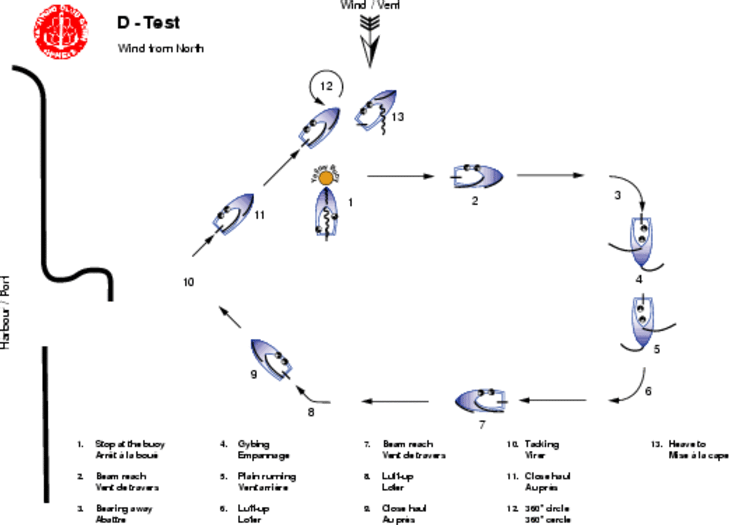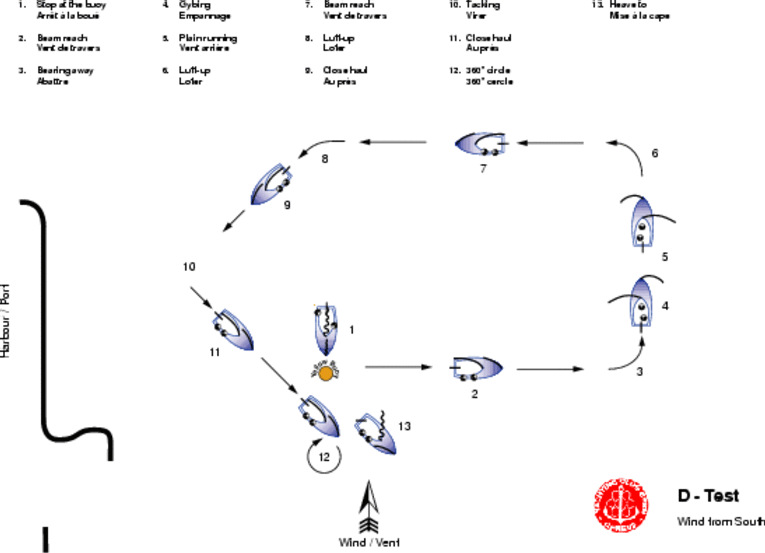
 Advanced Catamaran (EC) Test
Advanced Catamaran (EC) Test
Eligibility
Any active YCC member who:
- has Y or D key and a C key.
- has used spinnaker and trapeze on a catamaran ,this year and
- has sailed at least 4 times on a YCC catamaran this year, and
- has done 3 helper's sessions this year.
Once you have passed the EC test, you are entitled to use the YCC SL16, the Nacra 15 (in foiling, and non-foiling configurations), the Tornado and the Hobie Tiger as skipper. The legacy C test only gives access to the SL16.
Procedure
The candidate contacts the test coordinator responsible for the EC license.
The test coordinator appoints an examiner.
If the test follows an advanced catamaran course, then the examiner cannot be the person who gave the course.
Candidate and examiner agree on a date and time.
After the test, the examiner fills the test report and the test coordinator decides on the license.
The EC catamaran test requires a wind force of 3-4 Beaufort.
A wetsuit or a drysuit must be worn at the time of the test if the examiner judges that such protection is required.
Contents of the Test
Rules
Rules are tested before rigging. The following rules should be known:
Club Rules
Swiss Regulations
- Priority rules on the lake.
- Priority rules in and around the harbour.
See the booklet
Naviguez sur les eaux suisses ! or consult the
LNI and
ONI.
Knots
Knots are tested before rigging. The following knots should be known:
- Figure of eight (noeud en huit).
- Bowline (noeud de chaise).
- Flat knot (noeud plat) as used for the gennaker.
- Turning a cleat (noeud de taquet).
- Clove hitch (noeud de cabestan) for mooring the boat.
Rigging
Rig the boat in accordance with the rigging instructions.
Sailing
Try to ensure correct sail trim while sailing. The
helmsperson-candidate is expected to give clear orders to the crew when
executing manoeuvres. Both the helmsperson and the crew should compensate
heeling with their weight. Capsizing is to be avoided during this part of the
test.
Execute the following tour:
- Leave the harbour.
- Approach the yellow buoy outside the harbour and stop at the buoy, sails loose, bow into the wind. The crew touches the buoy with either a hand or the paddle. Try at most 3 times.
- From total halt, sail towards the coast opposite Versoix. Tack only if you find yourself going towards Versoix.
- Do a run at beam reach (vent de travers) for approximately a minute.
- Luff, tack and continue at close haul for approximately a minute. The crew uses the trapeze, if wind conditions permit, and demonstrates ability to anticipate gusts and waves. There should be no need for the helm to counterbalance the weight of the crew the moment he leans out in the trapeze.
- Tack again and continue at close haul for approximately a minute. The crew uses the trapeze if wind conditions permit. The helm needs to be in trapeze.
- Sail as tight a 360° circle as you can manage adjusting the sails and the rudder position continuously.
- Continue on beam reach (vent de travers) for approximately a minute.
- Bear away to plain running (vent arrière).
- Hoist the spinnaker and continue on broad reach for approximately a minute. The crew adjusts the spinnaker from the trapeze if wind conditions permit.
- Gybe and re-gain broad reach. Involuntary gybing, involuntary luffing after the gybe, going into a broach and re-gybing must be avoided.
- Execute two more gybes.
- Luff to as close to the wind as acceptable under spinnaker and sail for approximately a minute. The crew needs to be in trapeze and control the spinnaker from there.
- Bear away to running and lower the spinnaker. Parts of spinnaker may briefly touch the water while lowering, but the sail should not drag in the water.
- Return to the yellow buoy.
- Stop the boat close to the buoy with the jib on the windward side of the boat (heaved to - mise à la cape). The crew touches the buoy with either a hand or the paddle. Try at most 3 times.
- Change the helm. The new helm does the same manoeuvres and returns the boat into the harbour.
In case of wind from the N (sketch in PDF format):

In case of wind from the S (sketch in PDF format):

Capsizing
- The tester might ask for a capsize demonstration where the helm should do the main actions (be on the centerboard etc.) to righten the boat. This can be omitted if the tester knows that the candidate has successfully demonstrated his or her capsize abilities during a Dinghy course or club practice outing.
Unrigging
- Take down the mainsail in the water.
- Make sure neither the rudder nor the centreboard touches the ground.
- Empty the boat of water.
- Correctly fold and store the sails.
- Fix the cover on the boat such that rain will not accumulate in the cover.
- Tie the boat to the ground.
Norms
While you sail your course, the examiner watches for errors and
ranks them in three categories: red, of which you're not
allowed to make any; orange, of which you're allowed
to make 2 provided you make no other errors, or 1 with at most 2 blue errors in
addition; blue of which you can make 5, provided you
make neither red nor orange errors.
Severe Errors
- Errors which put a person in danger, or which would
have put a person in danger had the examiner not intervened. This includes not
having a sufficient number of buoyance aids on board, or not wearing them if
the conditions warrant this.
- Insufficient knowledge of, or non-respect of, priority
rules.
- A collision with another boat with you at fault, or
an action which would have resulted in a collision had the examiner not
intervened, no matter whether the other boat belongs to the YCC or not.
- Not being able to right your boat without
external assistance after capsizing.
- Inability to stop your boat by whichever means
other than capsizing.
Errors
- Unable to make without hesitation the three basic knots listed.
- Hoisting sails while not head to the wind.
- Running into the buoys in the channel while
leaving the harbour, while sailing or while returning.
- Failing to do one correct buoy stop in three
attempts. The buoy stop is valid if the boat comes to a total halt, the buoy
can be reached with a paddle from the boat, and the mast of the boat stays
downwind of the buoy.
- Failing twice to perform a controlled gybe, e.g.
luff or broach after a gybe, accidental re-gybe.
- The boat returns to the original course after an attempt at going-about.
- Involuntary capsizing, except when caused by a
violent gust.
- Leaving a circle with a radius of 3 boat lengths while doing the 360° loop.
- Failure to heave-to, i.e. stopping the boat with
the jib on the windward side, at the end of the course.
Warnings
- Problems while rigging the boat, e.g. hoisting a
sail entangled in itself or with the halyard entangled in the shrouds, trapeze
or spreaders.
- Sailing towards Versoix after the first stop near
the yellow buoy with the boat facing the wind.
- Incorrect angle to the wind.
- Incorrect sail trim.
- Needing additional tacks while approaching the
buoy at the end of the course.
- Excessive margin while approaching and rounding
the buoy.
- Touching the buoy while passing by, at the end of
the course.
- Need for corrective action by the examiner while unrigging.
Original drafted by Vincenzo Innocente and Udo Wagner, drawings by Udo Wagner,
norms from Michel Cornevin.
Last modified May 2023 by MCH
 Advanced Catamaran (EC) Test
Advanced Catamaran (EC) Test
 Advanced Catamaran (EC) Test
Advanced Catamaran (EC) Test
